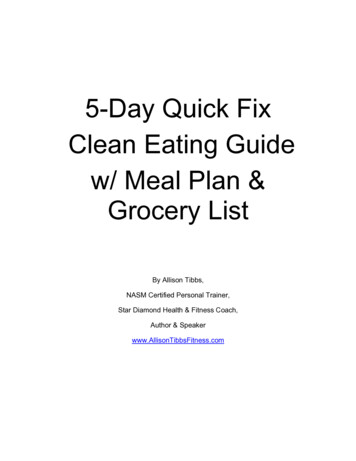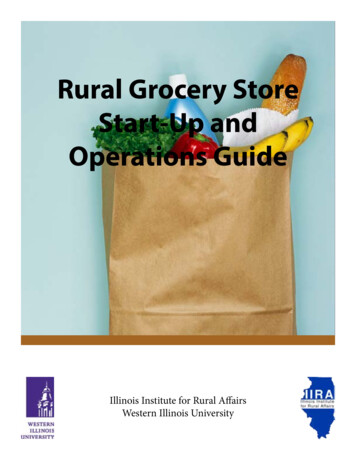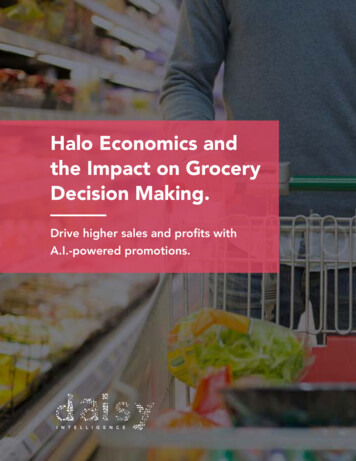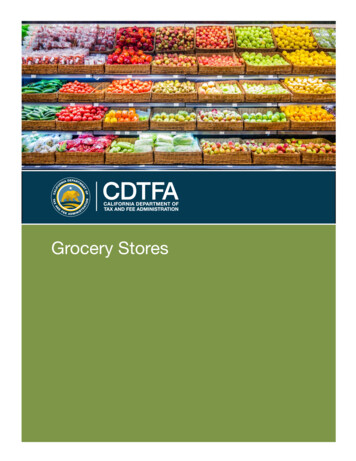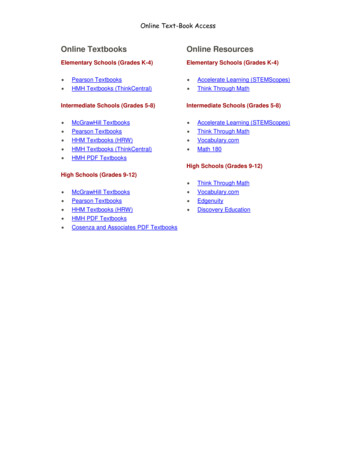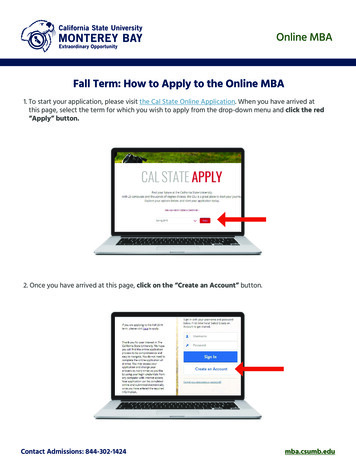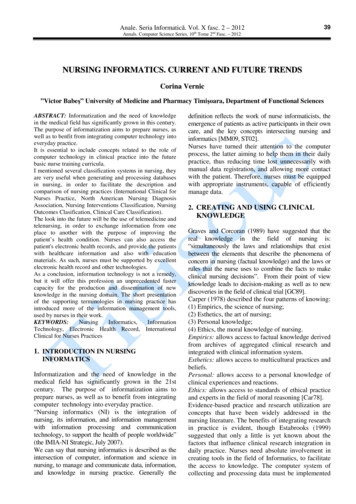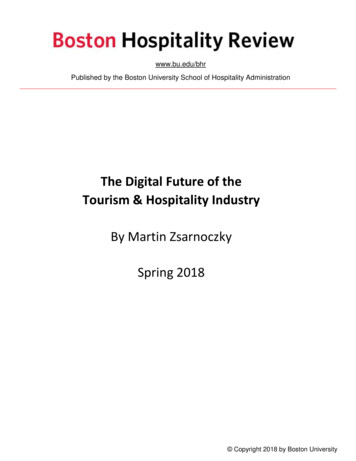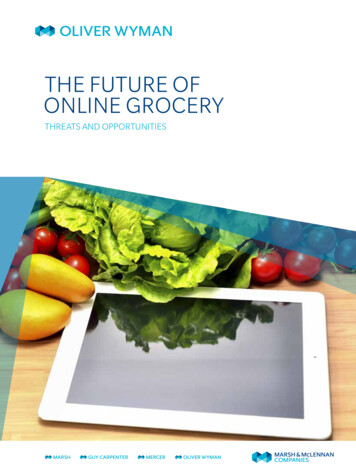
Transcription
THE FUTURE OFONLINE GROCERYTHREATS AND OPPORTUNITIES
“A modest efficiency improvement of10% by US online retailers would mean70% of the population could be servedprofitably by an online-only grocer withless than 7% market share.”2
THE FUTURE OFONLINE GROCERYFood retail has always been a tough business. Today’s major grocery chains have allweathered repeated attacks from new competitors and new formats, and are alwayslooking out for the next wave of competitive threats. Online grocery retail is such awave, and we believe that it will be economically viable in more markets than mostpeople think – and sooner than they think. Just as with past waves of new competition,the best operators will adapt, survive, and thrive. To meet the online threat,established retailers will need to upgrade their business’s capabilities – and those thatsucceed can gain at the expense of less well-prepared rivals.Although online shopping has long threatened bricks-and-mortar retailers in other sectors,so far it has had less impact on food retailers. But this is changing – online grocery is comingof age. Online grocers have already captured 6% of the market in the UK, largely driven byonline offerings from all major bricks-and-mortar players as well as a maturing offering fromonline-only player Ocado. Although online grocers currently have a smaller share of marketssuch as the US and Germany, they are growing steadily, and there are credible signs thatmajor players such as AmazonFresh and Walmart are ready to invest rapidly to acceleratethis growth.You may be sitting there thinking that online doesn’t really work in grocery, the economicsdon’t add up, so you will be safe. That is not the case. Or you may be sitting there thinkingthat your market has already reacted to the online threat, and the major disruption hasalready happened. That is also not the case.In this paper we assess the likely impact of e-commerce on the grocery market: where itis likely profitable, what it means for bricks-and-mortar food retailers, and how theyshould respond.3
WHERE CAN ONLINE-ONLY GROCERSBE PROFITABLE?Around the world a variety of online-only grocers have popped up, including Ocado (inparts of the UK), FreshDirect (in parts of the East Coast US) and Peapod (in the Midwest andEast Coast US). Some of these companies have been in business for more than 25 years, sowhile this is not a new model, there has been considerable growth in the past five years –with Ocado reaching profitability and AmazonFresh signaling the start of a wave of massiveexpansion. These are signs that this format is moving from a niche offering to something withboth staying power and the power to shape the industry.Of course, the online-only grocery business is challenging. Capital requirements, deliverycosts, fulfillment costs, and price transparency are all high. Customer spend can be lowerbecause of less impulse buying. Many customers resist the idea of having someone elsepick fresh food for their family, while others have “need it now” shopping patterns.Profitability is only possible with scale, and for many years barriers to entry were high. Mostcompanies with the capital and the know-how to build an online grocery business are alreadyin the structurally - advantaged bricks-and-mortar grocery business. In some concentrated,mature markets, retailers have had to enter the game after competitors have turned to onlineto try and gain an otherwise elusive competitive advantage. However, in many markets, thebricks-and-mortar retailers have had little incentive to pioneer a less profitable format thatwould cannibalize their existing sales.But with customer demand for online grocery shopping steadily increasing, online-onlyplayers have been stepping up to meet it – increasing the incentive for bricks-and-mortargrocers to enter the online business as well.How far online grocery grows will ultimately depend on where it is financially viable.By looking at the economics of a range of existing online grocers, we have modeled what ittakes to achieve financial success as an online-only grocer. We believe that in many parts ofthe world, online grocers can be profitable with lower market shares than those that havealready been achieved in the UK.Fundamentally, the market share required to break even depends on: Population density – affects cost of the “last mile” delivery Overall population – affects fixed asset leverage Market price levels – determine achievable gross marginsTaking the economics of best-in-class online grocers as a baseline, we have modeled howthese factors influence the viability of a range of grocery markets. Exhibit 1 shows theresults for the US. If anything, this gives us a conservative view on the viability of markets,as there are clear ways online-only retailers can boost their economics. For example, acompany like Amazon can gain a real advantage from attachment purchases from itsnon-food assortment. And all operators have the option of adding click-and-collect pointsto potentially reduce delivery costs, a topic discussed in the section “The Opportunity:Competing in the Online Grocery Business.”4
Exhibit 1: Market share required to break even for a pure-play online grocerSeattle – Tacoma – BellevueWANDMTAKIDORNVUTLas Vegas – ParadiseSt. LouisWIWYNECAMNSDIAILCOAZKSMOOKARNMTXHIDallas – Fort Worth – ArlingtionMarket share required to break evenUnder 3%3–5%5–7%7–12%MSLAMEVTNHMAPAIN OHCT RINJWVMD DEVAKYTNNCSCAL GAMITampa – St. Petersburg –ClearwaterNYFL12% The three example markets in Exhibit 2 illustrate the trade-offs at work. Both the TampaMetropolitan Statistical Area (MSA) and the St. Louis MSA have large populations andrelatively low market price levels, but St. Louis has much lower population density and asmall market price disadvantage. So despite their superficial similarity, the resulting marginto break even is considerably different. Las Vegas has a lower population level, slightlylower population density, but a high market price level – resulting in a lower breakevenmarket share.When we apply this calculation to more densely populated European countries, we see aneven more attractive market for home delivery. For example, with today’s economics, about60% of the German market can be served profitably.Exhibit 2: Comparing three market areas with different characteristicsMARKETPRICE LEVELRESULTINGMARGIN REQUIREDTO BREAK EVENUnder 3%MARKETPOPULATIONPOPULATIONDENSITYTampa – St. Petersburg – Clearwater2.7 MMHighLowLas Vegas – Paradise1.9 MMMediumHigh3–5%St. Louis2.7 MMMediumVery low5–7%If online grocers continue to become more efficient – not unlikely, since the format is stillrelatively new – it will open up more markets where they can break even. Exhibit 3 showshow even a modest efficiency improvement of 10% would significantly increase theproportion of the US population that could profitably be served by online grocers. In thisscenario – which we believe is a plausible “central case” – 70% of the US population could beserved profitably by an online only grocer with less than 7% market share.5
Exhibit 3: Market share required to break even after 10% efficiency improvementSeattle – Tacoma – BellevueWANDMTAKNVLas Vegas – ParadiseUTIAILCOAZKSMOOKARNMTXHIDallas – Fort Worth – ArlingtionMarket share required to break evenUnder 3%3–5%5–7%7–12%LAPAIN OHNJWVKYTNMSVTNHNYMIWYNECASt. LouisWISDIDORMNVACTMEMARIMD DENCSCALTampa – St. Petersburg –ClearwaterGAFL12% Of course, the online retailers’ own economics are only part of the story. In any givenmarket, how large a share they capture is also affected by inherent characteristics – such asthe age distribution of the population and the adoption of online tools for other commerce.But these are likely to be minor (and diminishing) constraints upon online retailers’ growth,based on the fact that market share in the UK is at about 6% (which, although split acrossmany different players, shows the attractiveness of online offerings to customers) and isstill showing signs of growth – with significantly higher share in some of the more denselypopulated regions. On the other hand, what established retailers do will make more of adifference: If bricks-and-mortar retailers can deliver better value or a better experience,things will be much tougher for the online grocers.Given these dynamics, retailers who enter the online business first and target the mostattractive markets can have a serious advantage and make it much harder for thosewho set up online operations later. In markets such as the UK and France, where onlinebusiness models have taken off, late bricks-and-mortar entrants are finding it difficult toget traction and are being forced to try creative things to jumpstart their efforts – such asMorrisons’ partnership with Ocado.This is not to say that new online-only entrants can’t still disrupt markets like the UKand France. There are big differences between the likes of Amazon and Googleentering the market and a late-entrant bricks-and-mortar player trying to get in the game.Amazon and Google can afford to play a much longer, lower-margin game. And theireconomics can look very different: either through the support of attachment purchases,as is the case with AmazonFresh, or through an innovative new model, as used byGoogle Shopping Express.For a bricks-and-mortar retailer, these dynamics present both a threat to the existingbusiness and an opportunity for a new source of growth and differentiation.6
THE THREAT: IMPLICATIONS FOR BRICKSAND-MORTAR GROCERYOnline grocery poses a threat to established grocers everywhere, but the exact nature ofthe threat varies from one market to another. In some, online-only home delivery optionsmay capture a large part of the market; in others, bricks-and-mortar grocers may moveand establish a mix of click-and-collect and delivery models. Either way, bricks-and-mortargrocers will feel a significant financial impact, as their slender margins make them sensitiveto even a small loss in market share. For a traditional grocer with 2% EBIT and a 20% volumevariable margin, a 10% loss in share to online would destroy all of its profit. Even a 5% sharewould be disruptive, and online grocery is already at 6% in the UK.But this does not spell the end for bricks-and-mortar stores and, in fact, the stores thatsurvive are likely to be more profitable than the average store today. Being one of thebricks-and-mortar grocers that survives will not be about beating online formats (althoughthat can of course help). Instead, it will be about each store winning local competitivebattles to be the last store standing in a given area. In other words, you don’t have tooutrun the bear – you just have to outrun the person standing next to you.Whether online grocery is already taking hold in your market (as is the case in the UK andFrance) or is in the early stages of growth (as in the US and Germany), the first step forbricks-and-mortar retailers is to recognize that this will inevitably mean a net loss of salesthrough their traditional bricks-and-mortar grocery channel. High operational gearingmeans that as stores lose sales, income will decrease by much more in percentage terms.The implication is that some – perhaps many – individual stores will actually becomeunprofitable. Exhibit 4 illustrates the effect of declining sales per store on operating income.Exhibit 4: The impact of falling sales on a company’s operating incomeOPERATING INCOMEStore A, year 1Store A, year 3. leads to a much largerdecline in margin0A small declinein sales.SALES PER STORE7
This means that bricks-and-mortar retailers will need to close unprofitable stores. Someof the sales lost through these closures will be clawed back by the remaining bricks-andmortar estate, making the remaining stores more profitable and better able to weather thechannel shift. However, many of these sales will end up with other formats or channels. Theexact impact of that channel shift depends on the way retailers respond. If retailers try tomaximize their cash profit, the impact could be very dramatic. If instead they just try to stayprofitable at a similar rate, they could keep open most of their stores. In a middle scenario atsteady state, we expect that an online market share of about 8% would ultimately mean thatup to 30% of bricks-and-mortar square footage would close in most of the geographies wehave modeled. We think two key patterns will emerge as a result: an increase in the disparitybetween the best and the worst sites, and greater challenges to winning customers with atraditional full-assortment grocery proposition.LOCATION, LOCATION, LOCATIONThe rise of online grocery retail will accentuate the disparity between the best and the worstsites. Poor locations will close, while strong locations will benefit from clawing back some ofthe sales from store consolidation. The challenge will be to beat local competition: The laststores left standing in each area will gain more sales from competitors that close than theylose to online. So now is an opportune time to re-think the real estate portfolio, assessingeach store on the battles it is fighting and the attractiveness of the natural customer base it isserving. At the simplest level, stores will fall into three categories:1. Stores that cannot be saved, where you should minimize your investments, harvestcash where possible, maximize the chance that sales are clawed back in your otherlocations, and reduce exit costs2. Stores that will survive in a base case scenario, where you should maintain and protectyour leading position but not over-invest3. Stores whose destiny can be changed, where you should concentrate your investmentin the elements of the customer proposition most likely to give the store a chance to beatits local competition8
ACCELERATION OF THE COLLAPSE OF THE MIDDLETraditional middle-of-the-road grocers have always been fighting a war on two fronts. Theyface competition from both sides of the
Of course, the online-only grocery business is challenging. Capital requirements, delivery costs, fulfillment costs, and price transparency are all high. Customer spend can be lower because of less impulse buying. Many customers resist the idea of having someone else pick fresh food for their family, while others have “need it now” shopping patterns. Profitability is only possible with .
